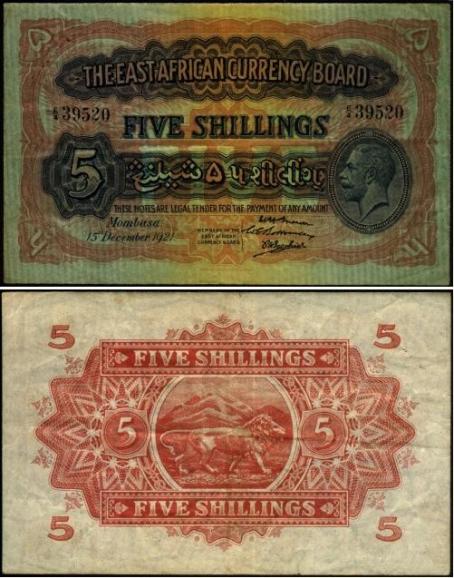Tanzania Currency- Banknotes
The first banknotes in this country were rupee
banknotes introduced in 1905 during the German rule. They were in
denominations of 5, 10, 50, 100 and 500 Rupien. Their images are shown
below. Very few the banknotes with face values of 500 rupee were issued
because not many people could own as much as that amount of cash; I was
unable to get their images.
5 Rupien
5 Rupien





1 Rupie





A Rubber stamp temporary banknote

1 Zanzibari Rupee






Banknotes released released under King George V were in denominations of 5, 10, 20, 100, 1000, and 10,000 EA Shilling
5 EA Shilling





(Picture was taken after the banknote had been delegitimatized. Punched holes indicate the delegitimization of the banknote)
By the value the shilling at that time, very few banknotes with a
face value of 1000 and 10,000 EA Shillings actually circulated. I
haven’t been able to get an image of the 10,000 banknote. In 1933, the
1000 EA Shilling bank note was retired from circulation.During the short lived reign of King Edward VIII, no banknotes were released. The next release was under King George VI. Under King George VI, the 1 EA Shilling was introduced in 1943 and the 10,000 EA shilling banknote was retired in 1947.
1 EA Shilling


10 EA Shilling

20 EA Shilling

100 EA Shilling

After the death of King Gorge VI when Queen Elizabeth II took the throne, the first release of banknotes under the queen were similar to those of her predecessor, however the 1 EA Shilling banknotes were retired from circulation. It seems that this was the only banknote that carried a value of one shilling in East African history.
5 EA Shilling




In 1958, the banknotes were redesigned to be more colorful with popular East African cash crops to represent East african economic activities than merely a lion and Mount Kenya. Denominations of 5, 10, 20, and 100 EA shillings were released. The 5 EA Shilling banknote showed cotton and cloves; the 10 EA Shilling showed sisal and tea; the 20 EA Shilling showed coffee and sunflower, and the 100 EA Shilling banknote showed coconuts, palms and pyre thrum. The East African shilling was no longer officially pegged to the pound, hence the 20 shilling banknote did not have dual values any more.
5 EA Shilling

10 EA Shilling

20 EA Shilling

100 EA Shilling

These new designs continued until after independence although by 1961, the number of members in the East African Currecy board had increased to 6 members, the banknotes released in 1961 had some slight modifications in the front face to accomodate six signatures of the board members as shown below.
5 EA Shilling

10 EA Shilling

20 EA Shilling

100 EA Shilling

The first post-independence release of the EA Shilling banknotes in 1964 had significant changes. The notes were in English and kiswahili; the face of the British ruler was replaced with a dhow (the reason for choosing a dhow is not yet known); and the back of the banknotes were also carried the same east African cash crops although in different images as shown in the following pictures.
5 EA Shilling

10 EA Shilling

20 EA Shilling


No comments:
Post a Comment